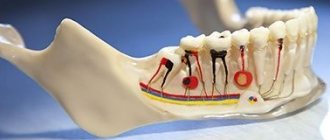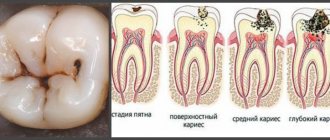Trigeminal neuralgia (trigeminal neuralgia) is a disease during which attacks of pain (intense, shooting, burning) occur in areas of innervation - areas supplying nerve fibers to the temporal, frontal regions, facial skin, masticatory muscles, ocular conjunctiva, and some muscles of the oral cavity ( for example, mylohyoid).
General information
Pain in the facial area is considered the most difficult in medicine, as it is associated with pathologies of the nervous system, ENT organs, dental system or eyes. However, trigeminal neuralgia is often the cause of such pain.
The problem is at the top of the ranking of neurological diseases due to a large number of factors: excruciating paroxysmal pain, social and work maladjustment (it is extremely difficult for a person to work productively, he is under constant stress), long-term treatment. Symptoms can be identified, but only a specialist can prescribe the exact cause of the disease and truly effective treatment. In the 5th city hospital of Minsk, all conditions have been created for high-quality neurological and neurosurgical care: from diagnosis to treatment.
Physiological and psychological causes of damage to the facial nerve:
- Nerve damage by polio, herpes, etc. viruses.
- Inflammation associated with teeth, jaw injuries
- Diseases of the nervous system - meningitis, cerebral palsy, multiple sclerosis, encephalopathy, etc.
- Circulatory disorders and brain tumors.
- Compression due to tumors or injuries, vascular pathologies
- Mental illness
- Stress
Come to the free webinar by Konstantin Dovlatov “Tired of lying towards your dream? 3 super exercises that will get you off the couch. A recipe for moving towards a goal from true achievers."
Learn how to stop suffering and start taking action to get well.
Pathogenesis
Trigeminal neuralgia develops due to disorders of the central component (blood circulation in the nucleus) or peripheral (peripheral parts of the nerve). For this reason, different approaches are used for treatment.
The pathogenetic mechanisms include vascular, endocrine-metabolic and immunological factors. Because of them, the sensitivity of the nuclei changes and a focus of pathological activity is detected in the central nervous system. After this, trigger (hypersensitive) areas arise in the innervation zones of different branches of the nerve, and when irritated, attacks of pain occur on the face.
The vascular factor is involved in classical neuralgia, when the nerve root is affected by a vertically crossing arterial loop.
Vasculoneural conflict (conflict between a nerve and a vessel) is especially taken into account in people who begin to harden the arteries and nerve fibers. With treginal neuralgia in the elderly, this is the most common case.
Autoimmune processes (in which the body attacks its own cells) cause inflammatory reactions during dental treatment and colds. In this case, it is they that cause trigeminal neuralgia and pain.
I'll punish myself!
Psychosomatics also explains attacks of the trigeminal nerve with strong feelings of guilt and sinfulness. Louise Hay writes that in this way a person seems to punish himself. Other authors also believe that this is a disease of overly responsible people. According to Liz Burbo, with neuralgia we need to look for pain in the past, which we hide from everyone. Depending on the location of the pain, there are different causes. The face is what we show to others. And if we try to put a good face on a bad game, then nervous pathologies develop. Metaphysical factors are primary here.
Primary and secondary neuralgia.
The most popular classification is related to etiology (nature of occurrence).
- Primary idiopathic . Arises as a response to vascular compression (squeezing) of the trigeminal root. Most often in practice, such compression occurs in the area of the brain stem.
- Secondary symptomatic . Consequences of infections, the occurrence of tumors and their growth, bone changes.
In order to recognize the nature of trigeminal neuralgia, tomography (neuroimaging) data of the skull and the nerve itself are used.
With true neuralgia, treatment, first of all, needs to focus on the nature of the disease, and with secondary neuralgia, there is a fight against the symptoms and elimination of the underlying disease.
Secondary neuralgia can have a central and peripheral form of manifestation. In the central form, pain appears in the area of one or more branches of the ternary nerve. In the peripheral form, the zone of entry of the nerve root into the medullary pons is involved; in most cases, the loop of the cerebellar artery has pathological changes.
Nature of pain and affected area
Another classification is based on the nature of the pain.
- Type 1 TN . Neuralgia of this type is characterized by a typically pronounced burning sensation. In this case, the pain is acute, but unstable, episodic. The duration of the episodes may vary.
- Type 2 TN . Constant and dull, aching pain.
Type 1 TN ternary neuralgia is more common, while type 2 TN is more rare. At the same time, the disease with this type of manifestation of the disease is most difficult to diagnose, since the picture of the disease is similar to a number of other neurological diseases, and sometimes dental problems, in particular problems with the temporomandibular joint.
The affected area and its scale may also be different, and neighboring zones may be involved. In this regard, the following levels of damage are distinguished:
- Damage to one of the peripheral branches of the trigeminal nerve . When the 1st branch is affected, the sensitivity of the skin is impaired (especially in the forehead and anterior scalp, eyelids, dorsum of the nose, mucous membranes of the upper part of the nasal cavity, a number of reflexes are impaired, for example, the superciliary one). When the 2nd branch is affected, the sensitivity of the skin on the cheekbones and cheeks is lost, the sensitivity of the skin near the outer corners of the eyes is lost, and there are problems with the sensitivity of the skin in the area of the upper jaw, lips, and nose. When the 3rd branch is affected, the lower part of the face (chin, lower lip), tongue, and sometimes there is a problem with the masticatory muscles (up to paralysis).
- Damage to the trigeminal nerve root at the level of the base of the brain . Most often, it is a lesion of the semilunar ganglion, located on the large root of the trigeminal nerve. Most often it is affected by viral diseases. Advanced neuralgia of the semilunar ganglion is fraught with the rapid development of conjunctivitis and keratitis. As a result, you need not only the help of a neurologist, but also an ophthalmologist
- Lesion in the area of the brainstem nuclei . The most painful symptoms are similar to “electric shocks”. Sensation may be lost in areas associated with any branch of the trigeminal nerve.
- Dental plexalgia . As the name implies, the localization is associated with the zone of innervation of the dental plexus. The pain is very excruciating. It feels like absolutely everything hurts: the palate, cheekbones, temples, ears, neck (especially the upper third), and the back of the head. The pain especially intensifies when pressing on the problem area.
- Damage to the pterygopalatine ganglion . The processes of the maxillary nerve and a number of fibers in the area of the carotid artery, nasal mucosa, and salivary glands are involved.
- Damage to the area near the orbit . Persistent unilateral headache in the area of innervation of the trigeminal nerve is combined with lacrimation, difficulty breathing, and redness of the face.
Causes of inflammation of the trigeminal nerve
Damage to the trigeminal nerve can be caused by both trauma (fractures, tissue ruptures, unprofessional conduction anesthesia) and destruction of the myelin sheath of the nerve itself (a typical problem for patients with multiple sclerosis).
But more often we are talking about the inflammatory nature of the pathology.
The most common causes leading to inflammation of the trigeminal nerve:
- inflammation of the membranes of the brain or spinal cord (meningitis),
- diseases of the paranasal sinuses (sinusitis),
- malocclusion,
- herpes transmitted to the ganglia (nodes) of the trigeminal nerve,
- hypothermia: everyone knows the phrase: “I got a cold on my nerve.” In fact, a person’s tissues become overcooled, and then the nerve becomes inflamed.
- bacterial infection of the upper respiratory tract, throat.
Treatment of trigeminal neuralgia in Saratov, how to treat trigeminal neuralgia in Russia
Sarklinik provides comprehensive treatment of trigeminal neuralgia in children and adults, treatment of inflammation of the trigeminal nerve (nervitis, first, second, third branches) in Saratov, Russia, which includes effective reflexology methods. You can cure trigeminal neuralgia in Saratov!
Sarklinik knows how to treat inflammation of the trigeminal nerve, how to cure neuralgia and trigeminal neuritis ! The following types of neuralgia are treated: neuralgia of the 1st (first) branch of the trigeminal nerve, neuralgia of the 2nd (second) branch of the trigeminal nerve, neuralgia of the 3rd (third) branch of the trigeminal nerve in children and adults. On the website sarclinic.ru you can see a doctor online for free. If you have neuropathy, nerve damage, pain, a cold, the trigeminal nerve hurts on the left, right, you have a cold, a cold, inflammation on the face, paralysis, paresis, you don’t know how to relieve the pain , then contact a doctor at Sarklinik.
Sign up for a consultation. There are contraindications. Specialist consultation is required.
Photo: Aniram | Dreamstime.com\Dreamstock.ru. The people depicted in the photo are models, do not suffer from the diseases described and/or all similarities are excluded.
Related posts:
Transient ischemic attack: symptoms, treatment of the brain
Brain stroke: ischemic, hemorrhagic, treatment, rehabilitation, consequences
Logoneurosis: treatment of logoneurosis in children, adults, how to treat
Facial nerve, facial nerve neuritis, treatment, inflammation, paresis, neuritis, neuropathy, facial nerve neuralgia
Incontinence, treatment of incontinence in Saratov, Russia, symptoms, signs, causes, types
Comments ()
Symptoms of inflammation of the trigeminal nerve
The following symptoms indicate nerve inflammation:
- Facial pain.
- Headache, more often migraine.
- Burning sensation, as if “being hit with an electric current” in the area of the cheeks, cheekbones, jaw, forehead, eyes. The pain intensifies when moving the facial muscles, chewing, noise, bright light, or touching the skin.
- Problems with the blink reflex (decreased amplitude) and, accordingly, increased eye vulnerability.
- Involuntary twitching of facial muscles (nervous tic).
- Irritability.
Diagnostics
Based only on a survey, a doctor can distinguish tertiary neuralgia from Sjostad syndrome (with this syndrome, longer attacks), post-herpical pain, and typical migraines. To understand the full picture, it is important to carry out a comprehensive diagnosis:
- Tomography. For accurate diagnosis and correct treatment, the most complete data on the state of the brain and the selection of a detailed scheme (the scheme is important for accurate positioning) when performing magnetic resonance imaging of the ternary nerve are extremely important. The most accurate data can be obtained from MRI with contrast.
- Tomography (scanning) scan of the trigeminal nerve. Makes it possible to create layer-by-layer images, identify neurovascular conflict, signs of destruction of the myelin sheath of nerves. The scan allows the doctor to get a complete picture of what the nerve being examined looks like and what is happening where it exits the brain stem.
- It is extremely important that tomography allows not only to identify that there is a neurovascular conflict, but also to understand its cause. This may be a conflict of the cerebellar arteries, a neuroma (neoplasm) of the nerve. In many cases, the trigeminal nerve scan is performed with a simultaneous scan of the facial nerve.
- X-ray of the jaws (if you suspect that the main problem is dental).
- Angiography. Important for verification (confirmation) of the vascular origin of compression with an impressive size of the aneurysm and vascular loop or aneurysm.
Also, in most cases, blood and urine tests are prescribed (the role of these studies is especially valuable in pathologies that arise as a result of infectious diseases).
Treatment
Treatment is aimed at relieving pain and preventing relapses of the disease.
For milder cases of the disease, drug treatment can help; for advanced stages and large affected areas, surgical treatment is used. It also helps to overcome the nature of the disease itself.
Physiotherapeutic techniques are also used in treatment. But most doctors are inclined: they are effective not as primary ones, but only as auxiliary ones: enhancing the effect of conservative drug treatment, and can also be used after surgery at the rehabilitation stage. For example, drug treatment in the acute stage can be effectively combined with light therapy, especially infrared ray therapy in a small dosage. In the acute period and at the time of rehabilitation, phonophoresis, electrophoresis, and darsonvalization provide the desired effect. In the non-acute phase, it is useful to take medicinal baths (for example, with minerals), massages, acupuncture, and paraffin therapy.
Drug treatment
For conservative therapy, the following medications are prescribed:
- Drugs to combat symptoms (pain) . The most common drugs used in drug treatment are carbamazepine, finlepsin, and tegretol. The drug of first choice in most clinics is carbamazepine. It is effective in relieving pain in 70-80% of patients with trigeminal neuralgia.
- Antispasmodics and muscle relaxants of central action . One of the common medications in this situation is baclofen.
- Alcohol blockades (injections) aimed at “freezing” the affected area of the face. The blockades have an effect, but it is short-lived. Therefore, such injections are often resorted to as a temporary measure, for example, in preparation for surgery.
- Metabolic drugs . Their role is important for stabilizing the energy potential of cells and creating an antihypoxic effect.
- Anticonvulsants . Helps slow down the transmission of nerve impulses.
- B vitamins . They have a neurotropic effect (they improve the metabolism of mediators and certain analgesic activity, therefore enhancing the effect of painkillers).
Surgery
Surgical operations are the most effective for combating trigeminal neuralgia. They make it possible not only to eliminate pain, but also to eliminate the chain of impulses and influence the conflict between the root of the cranial nerve emerging from the brain stem and the vessel that adjoins it.
And, if the cause is just such a conflict, doctors recommend immediately thinking about surgery, and not stalling for time and trying to solve the problem with medication.
In this case, microvascular decompression of the trigeminal nerve root is considered the most effective and safe (the nerve is preserved). The operation involves installing a gasket (protector) between the nerve and the vessel.
Microvascular decompression of the trigeminal nerve root is a transcranial endoscopic intervention and is performed through a mini-access (in fact, we are talking about a cosmetic incision - no more than 2.5x2 cm, minimal blood loss, no long-term rehabilitation required)
Mechanical destruction of peripheral branches, glycerin rhizotomy, laser thermocoagulation, and radiofrequency destruction can also be used. They allow you to cope with the victory over pain with dignity, but unlike microvascular decompression, alas, such operations do not have the task of preserving the nerve. Therefore, such operations are used more often in cases where microvascular decompression of the trigeminal nerve root is impossible for some reason. For example, glycerin rhizotomy is often the only possible way to combat neuralgia in patients in severe physical condition at an advanced age with a list of other diseases.
Modern surgical techniques, akin to mechanical destruction, make it possible to eliminate additional destructive interventions and at the same time stimulate the necessary deep structures.
Among the complications of surgical intervention using glycerol rhizotomy, radiofrequency destruction, there are sensory disturbances on the face, keratopathy (the occurrence of corneal dystrophy).
Possible complications after microvascular decompression may be ischemic infarction of the brain stem, air embolism, damage to the trochlear nerve, the occurrence of cerebellar hematoma, paresis (reduction) of the facial muscles.
For this reason, it is extremely important to clearly weigh the degree of risk for the patient and choose the right surgical technique. Whether one or the other is suitable in each specific case depends on the individual characteristics of each patient. Careful attention to these details helps minimize the risks of complications.
Where the operation is performed is also important. All the nuances are important: how accurate the preliminary diagnosis is, the qualifications and experience of the neurosurgeon.
PSYCHOSOMATICS
I had to work here with a man who was tired of trigeminal neuralgia. I would like to share with you my findings on this issue, or more precisely, on the issue of the psychological reason underlying such changes in the body. I will be glad if someone finds something from this article useful.
In traditional medicine, trigeminal neuralgia is a chronic disease manifested by attacks of intense, shooting, burning pain in the area of innervation of the trigeminal nerve.
_________________________________________ A few words on the topic of anatomy for the overall picture. If you are not interested, feel free to skip this part:
Nervous system.
It ensures the functioning of all organs of the human body, as well as the body’s connection with the external environment, responding to stimuli from there. The external environment is perceived through nerve endings - receptors. Any irritation is perceived by the receptor, transmitted to the central nervous system, processed there and the central nervous system sends a response to different parts of the body. The purpose of the response is to adapt to new circumstances. It also underlies any symptoms, that is, changes in the body. I will tell you more in detail during the course.
The nervous system is divided into: • the central nervous system - the brain and spinal cord • the peripheral nervous system - the spinal and cranial nerves, as well as other elements of the nervous system lying outside the spinal cord and brain. The peripheral nervous system is divided into somatic and autonomic (autonomic). • the somatic nervous system communicates the body with the external environment: perception of irritations, regulation of movements, etc. • autonomic - regulates metabolism and the functioning of internal organs: heartbeat, intestinal motility, gland secretion, etc. All this works in close interaction.
The somatic part of the peripheral nervous system is formed by sensory nerve fibers coming from various receptors and motor nerve fibers innervating skeletal muscles. That is, they provide sensory and motor skills of the body - “I feel” and “I move.” Each segment of the spinal cord contains one pair of nerves containing sensory and motor fibers. Each segment corresponds to a specific area of the body. There are 12 pairs of cranial nerves leaving the brain. They also contain sensory and motor fibers. The trigeminal nerve is one of the largest pairs of cranial nerves. For clarity, I posted a picture with the article. It shows the main branches of the trigeminal nerve (ophthalmic, maxillary and mandibular) and where it is located. This will come in handy.
So: the trigeminal nerve is located in the face area, belongs to the peripheral nervous system, has sensory fibers, and provides sensitivity in the face area.
I think that to continue the topic of the trigeminal nerve, an anatomical educational program is enough. Let's get to the point. ___________________________________________
In traditional medicine, trigeminal neuralgia is considered a chronic disease. I am sure that this, as in all other “chronic cases,” is due to the fact that modern medicine, using an anatomical approach to diseases, does not take into account the effect of the psychogenic factor. But I’ve already tired of repeating this and about Hippocrates’ holistic approach.
In this article we will add our “fifth element” to the topic of trigeminal neuralgia, namely the human factor, namely the psychological component that underlies such a diagnosis.
Despite the identical-sounding diagnosis, from the point of view of Biology, there are several psychogenic causes for trigeminal neuralgia, or rather three. As a result, several types of changes in different tissues that lead to that very intense, burning pain in the face. Let's look at each of them.
Reason #1: Self-depreciation conflict: “I blame myself for losing face and respect”
In this case, changes occur in the bone tissue of the facial part of the skeleton (tissue of mesodermal origin).
The basis for changes in all tissues of the new mesoderm is the conflict of self-depreciation. In this case, we mean self-depreciation in relation to the person.
What does it mean? The experience might sound something like this:
“Oh God, what a fool I am, I lost my face in this situation.”
“I lost respect and it’s my fault”
“What do people say about me now, I failed.”
If a person suffered from such a conflict and all the conditions for the transition of a psychological conflict to the level of biology were met, that is, the situation was dramatic, unresolved, unexpected, perceived in isolation and occupied all the person’s thoughts, then changes in the body will occur.
In this case, in the active phase of the conflict (remember about 2 phases!!! - if you don’t remember, see the introductory article and my video on YouTube) degradation (reduction) of bone tissue cells will occur. This degradation = decrease in bone cells = osteolysis will occur in the areas where the trigeminal nerve passes. But as long as a person suffers from his conflict, he will not feel anything. On the contrary, sensitivity in the active phase in all tissues of the new mesoderm is reduced. You remember this.
When the biological conflict is resolved and the person processes or comes to terms with the traumatic situation, the second phase will begin - the recovery phase. Bone tissue restoration will occur against the background of edema. The swelling will narrow the channels through which the trigeminal nerve passes and pain will occur as sensation returns during the recovery phase.
Pain here will indicate that the conflict of self-esteem has been resolved, the reputation has been restored, or the person has simply calmed down about this. But instead of opening the champagne and celebrating this, the person most likely panics because of the pain that has arisen and again devalues the face on this basis. A vicious circle arises and the pain can remain for a long time.
I’ll say this again because it’s important: pain can be fueled both by the experiences that triggered the biological conflict and by feelings about the pain in the face itself.
Solution: we remember the situation that triggered the conflict, realize it, do everything so as not to suffer from it again and finally open the champagne)) Regarding pain, we say: “this is temporary, you just need to let the body recover.”
Reason No. 2: Conflict of separation (with a person, reputation, etc.) in relation to a person: “I suffer from the fact that I have lost face, respect”
There is a difference in experience here compared to the first point. If in the first case a person scolds himself, then in the second he does not scold, but suffers from the loss of respect and attitude of some people (the context of the face remains):
“I look terrible in front of these people.”
“My image is ruined”
“I don’t want people to look at me like that, treat me like that”
“He made a laughing stock of me”
“They don’t take me seriously”
“I'm being ignored”
“He doesn’t want to see me”
In this case, the epidermis (tissue of ectodermal origin) will change.
In the active phase of the conflict (during suffering), the sensitivity of the epidermis in the facial area decreases, and the trigeminal nerve is directly involved in this. The person will not feel any symptoms, although the epidermal tissue will already be ulcerating, trying to help the person adapt. I’ll also tell you everything in detail during the course – why, why, how certain tissues will change.
The biological meaning of these changes is that, due to numbness, one can “forget” about the loss of face, respect and image, not feel the pain of this loss, and at the same time, due to the thinning of the tissue, regain the lost contact (get closer). We remember that all biological reactions are primitive in essence. They arose during evolution and helped species change, which still happens during illness, when an individual feels that he is ill in this external environment. And if we have already allowed experiences to transition to the level of biology, due to the lack of awareness and psychological defenses, then we will have to lower them to this level.
After resolving the biological conflict and calming down, the second phase of any disease begins - the recovery phase. In it, as in the first case, sensitivity increases, pain appears and trigeminal neuralgia is diagnosed. Here, when the epidermis is restored, swelling, redness, and elements of inflammation may be observed.
Reason No. 3: A very severe conflict between loss of face and respect
What distinguishes it from the second point is precisely its rigidity, a shade of cruelty and rudeness. These shades need to be looked for when looking for a triggering situation.
“He hit me in the face, humiliating me in public.”
“My dignity was completely trampled in public”
“This incriminating evidence destroyed my face”
etc.
In this case, the periosteum of the facial bones will change (also tissue of ectodermal origin, which means it reacts to separation conflicts (with something or someone associated with the face).
Note: you know that the periosteum surrounds the outside of the bone. The peculiarity of this ectodermal tissue is that pain during its changes occurs in the active phase of the conflict (this happens rarely and in strictly defined cases. Basically, any pain and sensitivity appears already in the recovery phase).
Already in the active phase of the conflict, those very intense, burning pains in the facial area appear, which lead to the diagnosis of “trigeminal neuralgia”.
How to understand that with trigeminal neuralgia it is the periosteum that is involved? The pain will be more intense, but since there is nothing to compare with, this parameter disappears. We use others. Since, unlike the previous two cases, pain occurs in the active phase, the tissues of the face, arms and legs will be cool and dry. During the recovery phase, body tissue always gets warmer (it was not for nothing that it was once called the “hot phase”). In addition, in the active phase there cannot be swelling, redness and inflammation; these are also common symptoms of recovery. Therefore, a diagnosis of trigeminal neuralgia has been made, or there is simply a strong, burning pain in the area of the branches of the trigeminal nerve, while the arms, legs, face are cool, there is no inflammation or swelling on the face, we are talking about the periosteum and you need to be aware of the brutal, rough situation in which the man lost face and self-respect.
During the recovery phase, the pain decreases and goes away. It can return for a short time only in the middle of the recovery phase in the so-called epicrisis. During an epicrisis, the pain will be more intense, severe, but short. The duration depends on how long the person was in the active phase.
Remember that in the article about tooth enamel or heartburn and bile ducts, I wrote that I love cases when pain occurs in the active phase. Why? Let me remind you. Because we can immediately identify and resolve our biological conflict. It is relevant, easy to understand, and the pain will begin to go away immediately after awareness, response and resolution of the problem situation.
Let's summarize:
As we see, all cases in which we are talking about trigeminal neuralgia are united:
1. Pain 2. Experiences of loss of face and respect with one shade or another
You will need to figure out:
1) what phase of changes in the body and living the biological conflict are you in? 2) what specific situation caused the biological conflict.
Next, you will need to resolve your conflict once and for all, so that you never worry about such things again. This may require a change in outlook, but it is always rewarded many times over. If you can't cope, you need help, come. But every person can do this. I was convinced many times. You didn't do anything special to get sick, you were just worried. So don't do anything special to get better - just realize all the connections and stop worrying.
Experiencing pain can increase the suffering associated with this area of the face. Therefore, it makes sense to seek the help of traditional or alternative medicine specialists to relieve pain.
With suffering associated with the face, in literal and figurative senses, as with all other suffering, you need to find a way to come to a state of calm. We need to relieve the emotional tension. And then the body will calmly recover after some time and there will be no relapses. Look for what will help you stop suffering. This is your task in this case. Perhaps simply relieving physical pain will help if the conflict is focused on them, and the suffering that triggered the changes has long ended. Or perhaps a change in worldview is required, which lacks such views as:
“I allow people to say and think about me whatever they don’t want, I don’t react to it” “I choose not to react to the words of some people” “I am who I am, and there is nothing terrible in that” “Yes, I I make mistakes like all people. If I can, I'll fix it. If I can’t, I’ll say “Yes” to this and move on.”
Be healthy!
#neuralgiatrigeminalnervapsychosomatics #neuralgiaNGM #neuralgiaBiology
Procedures
An alternative for patients who are contraindicated for complex operations, but drug and physiotherapeutic treatment does not provide an effect, may be the following procedures during an exacerbation:
- Injection of glycerin with a hollow needle through the cheek . The procedure allows you to influence the fibers responsible for pain, but careful monitoring of the procedure is problematic. Only 80% of patients experience real relief.
- Balloon compression . It is carried out through the skin using a catheter. A big plus of the procedure is the ability to provide immediate pain relief. Disadvantage: Requires general anesthesia.
- Stereotactic rhizotomy under the influence of electrical impulses . The pain relief effect is high, but in addition to eliminating the symptoms of neuralgia, unfortunately, nerve cells also die. Like balloon compression, the procedure requires general anesthesia.
- Development of hypochondria, depression.
Traditional medicine methods
The old recipes of our grandmothers will also help to alleviate the condition:
- Rinse your mouth with warm chamomile .
- Warming with an egg or cloth bags filled with hot cereals, salt .
- fir oil into the skin .
- Baths with hot water and young aspen bark .
These methods can provide relief from pain, but remember that with such complex diseases as trigeminal neuralgia, psychosomatics is a very important part of the treatment!
Prevention
Inflammation of the trigeminal nerve is not only important to treat promptly. It is important to prevent relapses, and here prevention plays a huge role:
- Avoid any drafts . It is important and necessary to ventilate the room, but do not get exposed to drafts of air, do not work, do not sleep under the air conditioner.
- Avoid hypothermia of the face and head . Don't ignore hats and scarves during the cold season.
- Protect your head and face from injury.
- Visit your dentist regularly . Avoid periodontitis (inflammation of the tissue around the roots of the teeth). If you treat caries, pulpitis, and periodontitis in a timely manner with modern dentistry, you can avoid it.
- Be careful about herpes . This is not just a “cold on the lips”, but a disease that can provoke the occurrence of ternary neuralgia.
- Fight psycho-emotional stress . Meditate.
- Take up exercise therapy . Focus on exercises that are aimed at working muscles (improving their tone) and increasing heart rate (cardio training).
Remember! Relapses are cyclical. Moreover, exacerbations are more common in the autumn-spring period. Therefore, at this time, pay the most attention to prevention.
Consequences and complications
It is important to start treating neuralgia in a timely manner. Untimely treatment is fraught with the following complications:
- Continuous pain (both headaches and facial pain).
- Paralysis of the facial nerve and, as a result, facial asymmetry.
- Weakening of hearing and vision.
- Weakening of facial muscles, appearance of wrinkles.
- Behavioral disorder. Constant fears. The person constantly thinks that he may have another attack. Therefore, he tries to move minimally when chewing (or chews, moving food behind one cheek), and smile a little.










